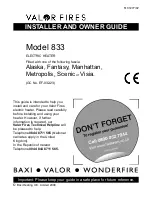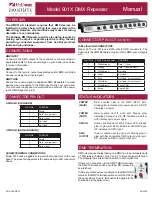
Service flap (fig. 2E).
Make a hole of 285 mm x 194 mm (h x w) for the service
flap.
Fit the inner frame (1). If you are building a brickwork
chimney breast the frame can be built in at the same time.
For a chimney breast of any other material, glue/cement the
inner frame in place or fit it with four countersunk screws
Ex-works, the gas control block is mounted under the
appliance.
Remove the gas control block from the appliance.
To do this:
Undo the flexible gas pipe (spanner 17), the aluminium pilot
light pipe (spanner 10) and the thermocouple (spanner 10)
and carefully unwind the pipes, making sure there are no
kinks.
Now remove the gas control block.
Lead the pipes to the required position, making sure that no
dirt gets into them.
Mount the gas control block on the brackets (2) on the
inner frame.
Connect the pipes to the back of the gas control block.
Make sure that the flexible hose and the aluminium pipe
connections are gastight.
First screw the thermocouple on by hand, and then tighten
one quarter turn with the spanner.
Place the remote control receiver in the tray (3). Make sure
the L.E.D. is pointing forwards.
Fit the outer frame with flap (4) to the inner frame using
the two self-tapping screws (5).
The outer frame can be fitted with the flap turning to the
left or the right, as required.
N.B.: Because of the temperature, the service flap should be
fitted as low as possible.
The feet of the appliance must also be taken into account
when installing the Saxo Scenic. Figs. 2c and 2d show the
area in which the service flap can be fitted.
Possible connections (fig. 4)
The external duct can pass through either the wall or the
roof; the connections to both supply and flue pipes should
meet the following requirements:
• The first metre of pipe should always be fitted vertically,
except example 5 in fig. 4.
• The horizontal length of pipe should never be more than
4 metres and a wall duct.
• The maximum length of vertical pipe is 12 metres.
Allow 2 metres for a bend of 90° and 1 metre for a 45°
bend.There is no need to allow for the length of the wall
or roof duct.
The maximum total length is the sum of the pipe lengths
plus the equivalent length for the bends (see the 5
examples in fig. 4).
The roof duct set, the supply and flue pipes, the concentric
pipe and bends are packed individually and supplied
together with a clip binding with sealing ring.Tile flashing
or adhesive flashing is also available for use with a duct
through a slanting or flat roof respectively.
NB:
This appliance may only be installed using the flue
material ø150/ø80 supplied by DRU.This has been
approved together with the appliance to comply with all
requirements. DRU cannot guarantee that the appliance
will work correctly and safely if alternative installation
material is used.
Preparations for the installation of the
combined inlet-outlet system
• Select the required connection from the options shown
in figure 3.
• Erect the concentric pipes from the heater up. If the
structural situation requires that the first section of the
concentric pipe system be built in, take special note of
the required method of assembly.
• The appliance has a coupling section; fit the first metre of
pipe onto this. When correctly assembled, the blue
rubber sealing ring inside the pipe should be visible from
the top.
• Allow at least 5 cm between the outside of the
concentric pipes and the wall or ceiling.
Wall duct with concentric pipes
You must consider that for a wall duct, the first 1 or 1.5
metres of pipe must be fitted vertically. 1 metre for a
maximum of 2 metres horizontal pipe, and 1.5 metres for
a maximum of 4 metres of horizontal pipe.
• Determine the position of the appliance and the position
of the wall duct.
• Drill a Ø160 mm hole at the point where the wall duct is
required.Through flammable material Ø 230 mm.
INSTRUCTIONS FOR INSTALLATION
22
1
2
3
4
5
3
8
c-107
8
fig. 2e
Summary of Contents for SAXO
Page 50: ...ALLGEMEINE BEMERKUNGEN MIT BRIEFUMSCHLAG VERSENDEN IHREN INSTALLATEUR...
Page 70: ...66...
Page 71: ...Saxo 67...
Page 72: ......
















































